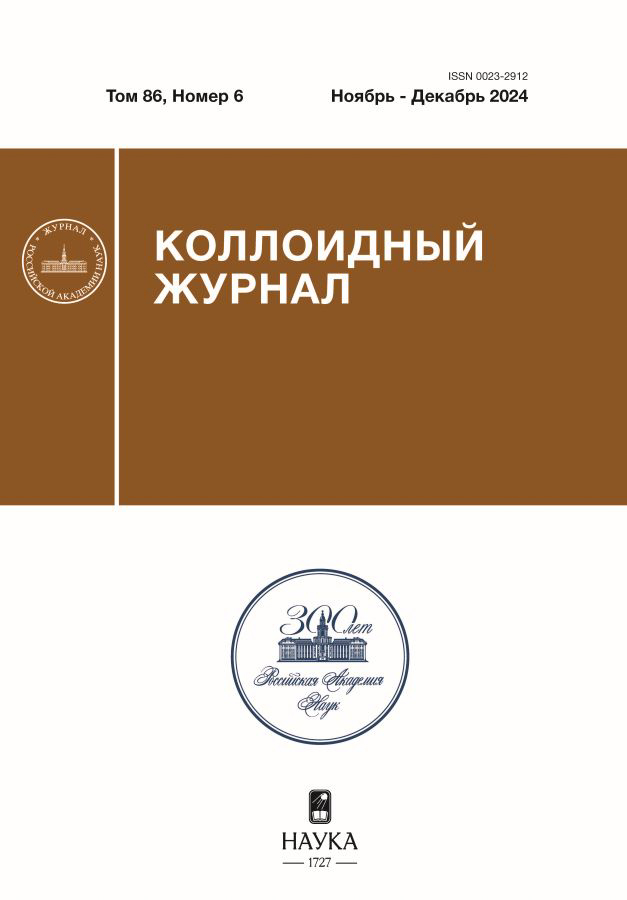Influence of iron cations on the hydrolysis of tetraethoxysilane and process of gel formation
- 作者: Titov E.N.1,2, Smalchenko D.E.2, Lebedeva O.E.2
-
隶属关系:
- ФГАНУ «Всероссийский научно-исследовательский институт молочной промышленности»
- ФГАОУ ВО «Белгородский государственный национальный исследовательский университет»
- 期: 卷 86, 编号 6 (2024)
- 页面: 817-823
- 栏目: Articles
- ##submission.dateSubmitted##: 29.05.2025
- ##submission.datePublished##: 15.12.2024
- URL: https://cijournal.ru/0023-2912/article/view/681030
- DOI: https://doi.org/10.31857/S0023291224060135
- EDN: https://elibrary.ru/VKMAYJ
- ID: 681030
如何引用文章
详细
The influence of small additions of Fe3+ ions on the processes of hydrolysis of tetraethoxysilane and subsequent polycondensation of products was studied using viscosimetry and dynamic light scattering methods. Experiments were carried out at 50оC, hydrolysis pH was 1.5; 2.5; 5.0 or 7.0, the amount of doping cation varied from 1.5 to 3.8 at. %. In the absence of a doping cation, the gelation time grows with increasing pH from 1.5 to 5.0, and at pH 7.0, polycondensation occurs without gelation. At pH 1.5, the introduction of a dopant increases the gelation time, at pH 2.5 and 5.0 it decreases. With increasing dopant content, the gelation time increases at all three pH values. The size of the particles formed during the polycondensation process depends on the pH and the amount of dopant. The smallest particles with a median diameter of about 10 nm are formed at pH 2.5. It has been suggested that the cause of all the observed effects is the incorporation of iron cations into the siloxane matrix. The degree of incorporation depends on the degree of hydrolysis of iron cations. This assumption is confirmed by the values of the electrokinetic potential of the systems under study and the dynamics of changes in the zeta potential with varying pH and dopant content.
全文:
作者简介
E. Titov
ФГАНУ «Всероссийский научно-исследовательский институт молочной промышленности»; ФГАОУ ВО «Белгородский государственный национальный исследовательский университет»
编辑信件的主要联系方式.
Email: titov.evgeniy96@gmail.com
俄罗斯联邦, ул. Люсиновская, 35, корп. 7, Москва, 115093; ул. Победы, 85, Белгород, 308015
D. Smalchenko
ФГАОУ ВО «Белгородский государственный национальный исследовательский университет»
Email: titov.evgeniy96@gmail.com
俄罗斯联邦, ул. Победы, 85, Белгород, 308015
O. Lebedeva
ФГАОУ ВО «Белгородский государственный национальный исследовательский университет»
Email: titov.evgeniy96@gmail.com
俄罗斯联邦, ул. Победы, 85, Белгород, 308015
参考
- Brinker C.J., Scherer G.W. Sol-Gel science: the physics and chemistry of Sol-Gel processing. San Diego: Academic Press. 1990.
- Lok P.S., Sriman K.B., Rahul K., Geetika M., Usha S., Garima S., Saurabh A. Sol-Gel processing of silica nanoparticles and their applications // Adv. Colloid Interface Sci. 2014. V. 214. P. 17–37. https://doi.org/10.1016/j.cis.2014.10.007
- Iller R.K. Chemistry of silica gel. New Jersey: John Wiley& Sons, Hoboken. 1978.
- Bansal N. Influence of several metal ions on the gelation activation energy of silicon tetraethoxide // J. Am. Ceram. Soc. 1990. V. 73. № 9. P. 2647–2652. https://doi.org/10.1111/j.1151-2916.1990.tb06741.x
- Атанасова В.Д., Швец В.А., Казанский В.Б. Исследование методами ЭПР и оптической спектроскопии ионов переходных металлов в цеолитах и их комплексообразования с адсорбированными молекулами // Успехи химии. 1981. Т. 50. № 3. С. 385–405. https://doi.org/10.1070/RC1981v050n03ABEH002553
- García-Aguilar J., Miguel-García I., Juan-Juan J., Such-Basáñez I., San Fabián E., Cazorla-Amorós D., Berenguer-Murcia Á. One step-synthesis of highly dispersed iron species into silica for propylene epoxidation with dioxygen // J. Catal. 2016. V. 338. P. 154–167. https://doi.org/10.1016/j.jcat.2016.03.004
- Tanjindaprateep S.P., Kidkhunthod P., Pattanasattayavong P., Ogawa M. Incorporation of iron (III) into nanoporous silica spheres // Colloids Surf. A Physicochem. Eng. Asp. 2024. V. 686. P. 133305. https://doi.org/10.1016/j.colsurfa.2024.133305
- López T., Méndez J., Zamudio T., Villa M. Spectroscopic study of sol-gel silica doped with iron ions // Mater. Chem. Phys. 1992. V. 30. № 3. P. 161–167. https://doi.org/10.1016/0254-0584(92)90218-W
- Downs E., Ao S., Siegel R., Schadler L. Transition metal doping of amorphous silica particles // J. Nanopart. Res. 2017. V. 19. № 337. P. 1–14. https://doi.org/10.1007/s11051-017-4005-5
- Shilova O.A. Synthesis and structure features of composite silicate and hybrid TEOS-derived thin films doped by inorganic and organic additives // J. Solgel Sci. Technol. 2013. V. 68. P. 387–410. https://doi.org/10.1007/s10971-013-3026-5
- Shilova O.A., Gubanova N.N., Matveev V.A. et al. Processes of film-formation and crystallization in catalytically active ‘spin-on glass’ silica films containing Pt and Pd nanoparticles // J. Mol. Liq. 2019. V. 288. P. 110996. https://doi.org/10.1016/j.molliq.2019.110996
- Тарасенко Е.А., Лебедева О.Е., Петерс Г.С., Велигжанин А.А. Влияние катионов металлов на кинетику образования и структуру гелей, формирующихся при кислотном гидролизе тетраэтоксисилана // Журн. физ. химии. 2019. T. 93. № 3. C. 1357–1361. https://doi.org/10.1134/S0044453719090280
- Gonçalves M.C. Sol-Gel silica nanoparticles in medicine: a natural choice. Design, synthesis and products // Molecules. 2018. V 23. № 8. P. 22–26. https://doi.org/10.3390/molecules23082021
- Naruphontjirakul P. Cations doped nonporous silica nanoparticles // 12th Biomedical Engineering International Conference. 2019. P. 1–4. https://doi.org/10.1109/BMEiCON47515.2019.8990288
- Pohaku Mitchell K.K., Liberman A., Kummel A.C., Trogler W.C. Iron (III)-Doped, Silica Nanoshells: A biodegradable form of silica // J. Am. Chem. Soc. 2012. V. 134. № 34. P. 13997–14003. https://doi.org/10.1021/ja3036114
- Shilova O.A., Khamova T.V., Panova G.G., Udalova O.R., Artemyeva A.M., Kornyukhin D.L., Kopitsa G.P. Sol-Gel-derived functional coatings for pre-sowing seed treatment // Coatings. 2023. V. 13. № 12. P. 1978. https://doi.org/10.3390/coatings13121978
- Kessler V.G., Seisenbaeva G.A. Molecular mechanisms of the metal oxide sol-gel process and their application in approaches to thermodynamically challenging complex oxide materials // J. Solgel Sci. Technol. 2023. V. 107. P. 190–200. https://doi.org/10.1007/s10971-023-06120-y
- Vrieling E.G., Sun Q., Beelen T.P., Hazelaar S., Gieskes W.W., Van Santen R.A., Sommerdijk N.A. Controlled silica synthesis inspired by diatom silicon biomineralization // J. Nanosci. Nanotechnol. 2005. V. 5. №. 1. P. 68–78. https://doi.org/10.1166/jnn.2005.010
- Darmawan A., Smart S., Julbe A., Diniz da C. J. C. Iron oxide silica derived from Sol-Gel Synthesis // Materials. 2011. V. 4. №. 2. P. 448–456. https://doi.org/10.3390/ma4020448
- Takeno N. Atlas of Eh – pH diagrams. Intercomparison of thermodynamic databases. National Institute of Advanced Industrial Science and Technology. 2005.
补充文件












